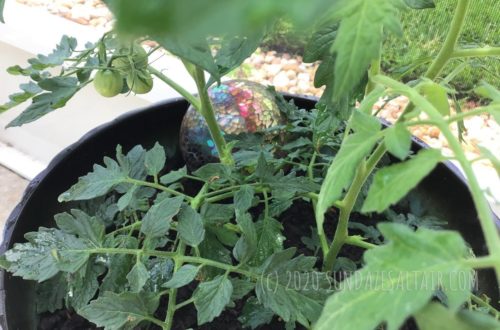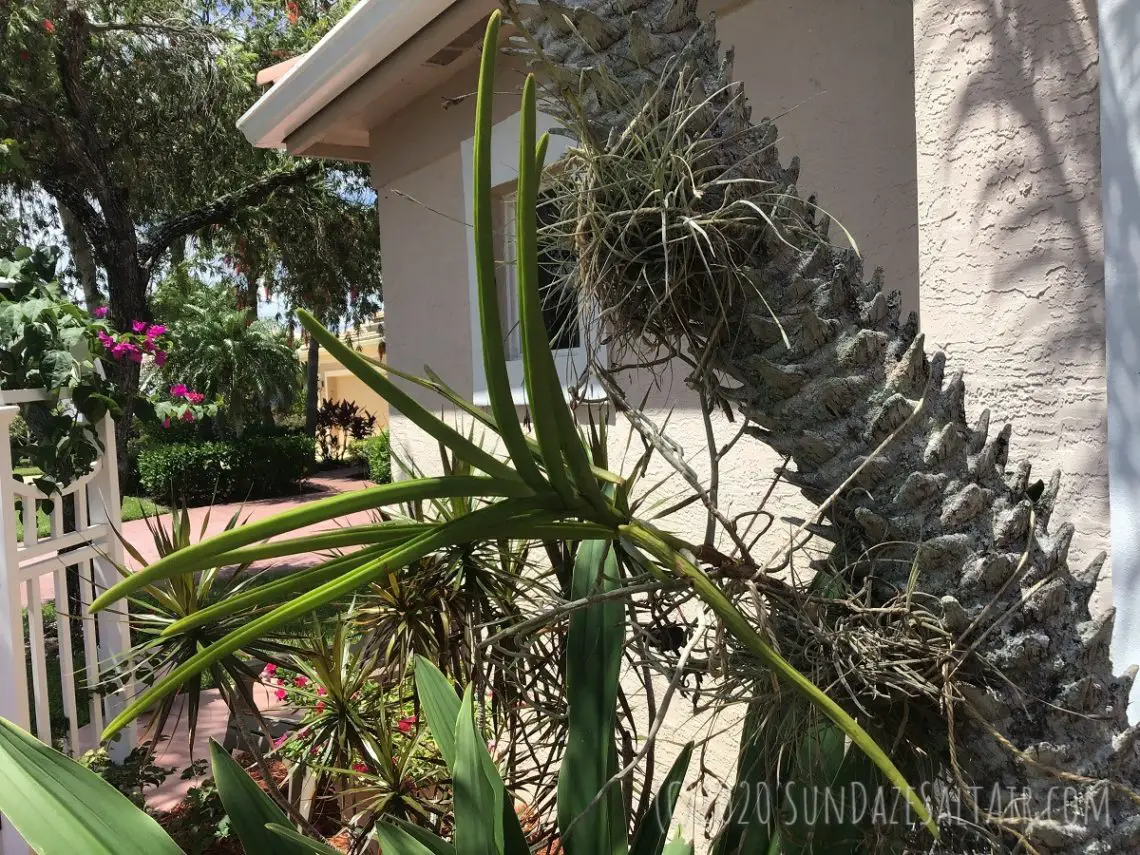
How To Get A Vanda Orchid To Bloom In A Few Easy Steps – Why Won’t My Vanda Orchid Bloom?
How To Get Your Vanda Orchids To Flower & Reasons Why Yours May Be Struggling
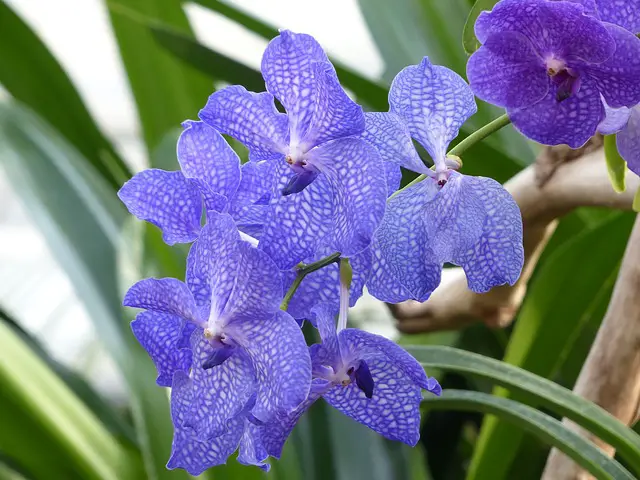
Why Choose Vanda Orchids? Exotic Beauty, Longevity, Delightful Fragrances & Ease of Care & Cultivation - Now Help Your Vanda Orchid to Bloom
This post will answer many of your questions about how to get a Vanda orchid to bloom, but first some information about what makes Vandas so magnificent. Vanda orchids are known for producing some of the most gorgeous and showy flowers, distinguished by their stunning array of vibrant colors and often larger flower size, although plants can range from miniature to huge, tall flora. Uniquely captivating, Vandas are standouts in many respects and, as a member of the exotic, other-worldly family of flowers known as orchids, that is certainly saying something.
The Vanda orchid rewards its grower with highly ornamental, exotically beautiful flowers, often producing long-lasting blooms that sometimes even offer a delightful and powerful fragrance -- even more so than roses. Ranging from scents of citrus to vanilla to spicy cinnamon, some even smelling like chocolate, if you can believe. The Vanda genus is probably best known for the incredibly vibrant assortment of colors it offers, even including a species that yields one of nature's rare vibrant blue flowers, the "Blue Orchid" or "Vanda Coerulea."
Unlike some species of orchids that only bloom once a year, a healthy Vanda has the potential to bloom multiple times throughout the year. As world famous symbols of tropical beauty, the beautiful blossoms of the Vanda even comprise Hawaii's renowned and stunning signature leis. Not to mention, flower breeders favor the Vanda for its ease of propagation and production of hybrids.
***Discover how to easily grow your Vanda orchids on trees in "How to Mount or Attach Your Vanda Orchid to a Tree & Why You Should"
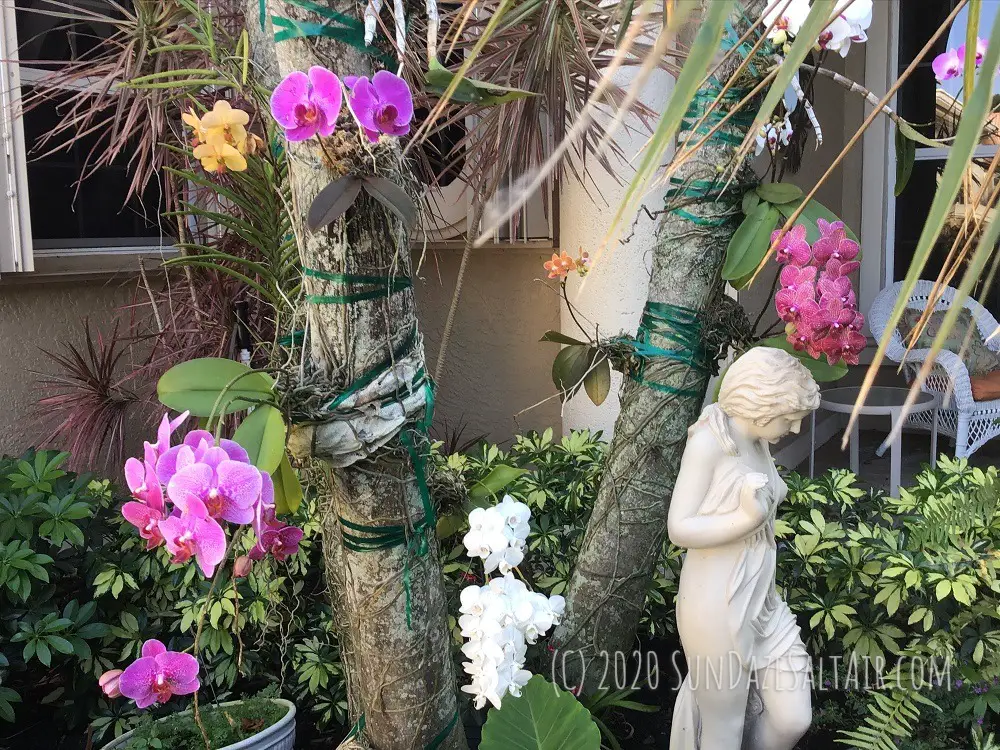
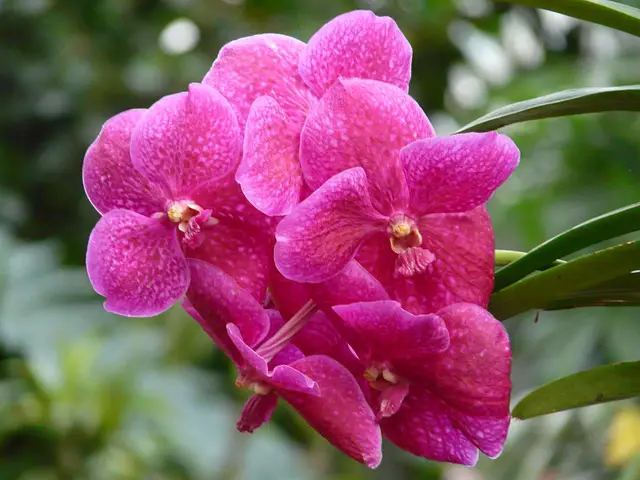

Vandas May Be Fussy But If You Follow Some Basic Care Guidelines, They Will Reward You With Magnificent Blooms
**Note: This post contains affiliate links for which a small commission may be earned if you decide to make a purchase through a link.
Requiring exacting but relatively simple care, a Vanda orchid plant has the potential to produce lushly flowered stems that will thrive almost with little effort, assuming you set them in their ideal environment, which isn't always easy to achieve. Since they are quite particular, I hope that the following set of Vanda care guidelines will help you cultivate, care for and bloom your Vandas, and turn it into a lifelong passion. It is, of course, the blooming part that tends to be the most challenging aspect of growing Vandas. Read on for more answers to your Vanda flowering questions. Once you master your Vanda's specific needs, it will be sure to reward you with regular blooming periods of the most beautiful, show-stopping blossoms around. Be sure to also check out, "How To Water & Fertilize A Vanda Orchid For Maximum Blooming Potential..."
Is your Vanda sick? See, "Why Are The Leaves Of My Vanda Orchid Turning Yellow? Five Causes & How To Save A Dying Vanda"
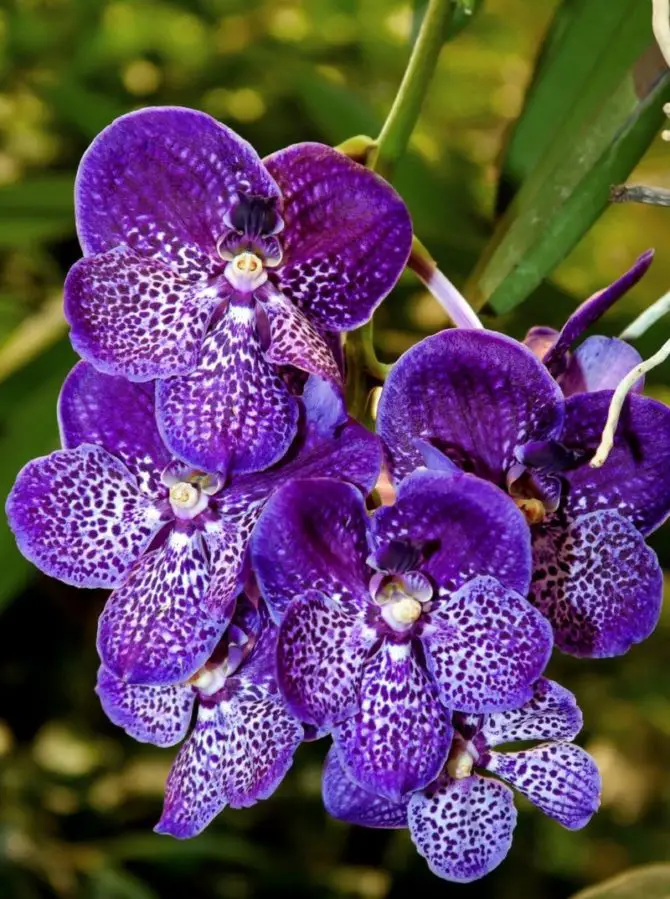
When & How Often Do Vanda Orchids Bloom?
Growing outdoors in USDA growing zones 9 through 11, Vandas have the potential for generous free-flowering displays of 1 to 5 inch (3-13 centimeter) flowers that bloom cyclically a couple of times throughout the year for up to approximately 4 to 8 weeks at a time. This, of course, is assuming it is growing under ideal conditions of high humidity, warm temperatures, abundant bright but indirect sunlight, and adequate hydration. It is notable that with Vandas, the occasional stress of cooler temperatures coupled with adequate sunlight can help promote flowering. Take advantage of slightly cooler fall or early winter temperatures to promote blooming but remember to move your Vanda indoors before any threat of frost.
Can Vanda Orchids Bloom in Temperate Climates?
Vandas are most likely to produce long spray-like bloom spikes during the sunny summer months in temperate climates where they can be outside most of the season so long as nighttime temperatures do not fall below 55 degrees Fahrenheit (13 degrees Celsius). Unless you have a greenhouse, in temperate climates, Vandas obviously will be mainly confined indoors as houseplants for most of the year due to their lack of cold tolerance. One notable exception is the Vanda coerulea, one of the rare true blue orchids and also one of the few orchids that thrive in locations with cooler temperatures.
As noted above, Vanda will appreciate some cooler autumn days in the 50-degree Fahrenheit range which can trigger Vanda blooming. Let your Vandas experience two to four weeks of lower autumn temperatures but be sure to move them to safety prior to any frost or freeze threats.
Can You Grow Vanda Orchids Indoors?
Vandas' exacting requirements mean they are especially challenging to grow in indoor environments. Even with optimum care, unless you have a very bright window with abundant amounts of daily sunlight, you may need LED grow lights to promote flowering. Add to that Vanda's requirement for high humidity, and you can see how it can be difficult to coax flowers out of a Vanda that is confined indoors for much of the year. More sun exposure from summer months outdoors, or the aforementioned grow lights, trigger the best chance of flowering.
When Considering Growing Vandas Indoors, Carefully Consider Size & Chose More Compact Varieties
When considering growing Vandas indoors, don't forget the large, fanned out foliage and long, stretching roots of the Vanda. Not exactly "houseplant on a windowsill" material. If you don't have a greenhouse, your best chance of growing Vandas indoors comes in the form of smaller, compact hybrids such as the aforementioned Vanda Coerulea and Vanda Tricolor.
Make your life easy and your Vandas happy by getting some slotted Vanda orchid baskets like the one pictured below which are the best way to replicate Vanda's epiphytic, open-air conditions growing in the wild...

 When Do Vandas Bloom in Warmer or Subtropical Regions?
When Do Vandas Bloom in Warmer or Subtropical Regions?
In warm tropical climate zones, Vanda orchids can, of course, flower any time of the year under ideal growing conditions, but usually bloom cyclically every few months for up to 4 to 8 weeks at a time. Again, the stress of occasionally cooler weather along with periods of bright sunlight can trigger some beautiful flowering...
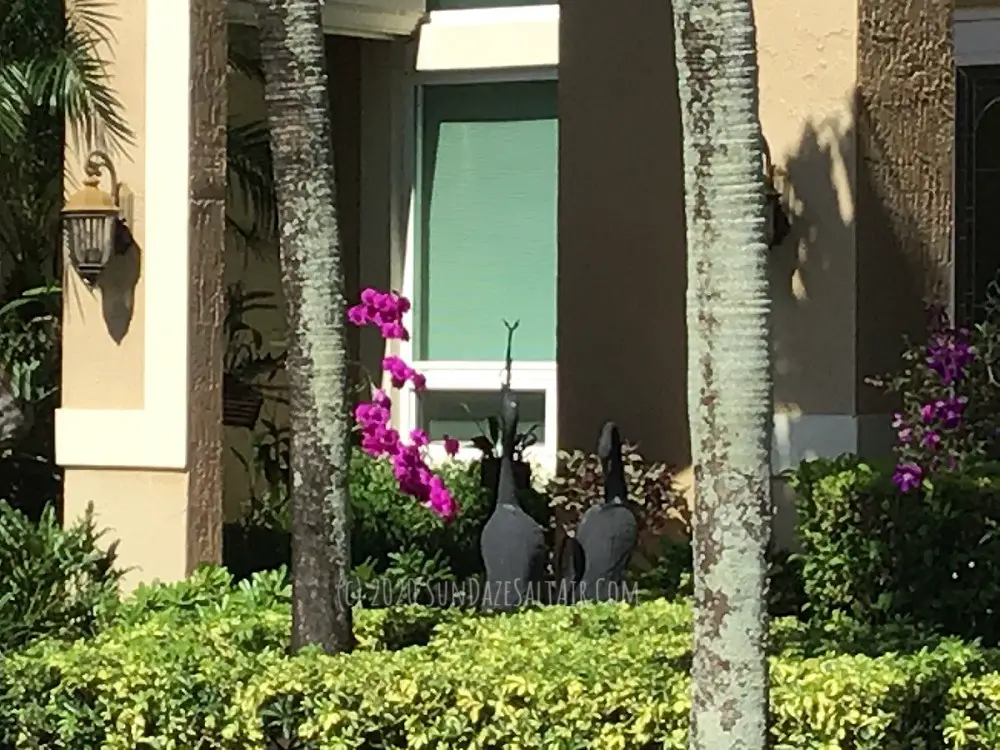
If Your Vanda Starts to Bud, Or Struggles to Open, What Should You Do?
As your Vanda begins to initiate flower buds, keep it moist by misting its aerial roots every day as you normally would to replicate Vanda's preferred rainforest-like humid conditions.
If Vanda buds ever appear to be stuck together with a sticky-type substance, try misting the buds with a little water to dissolve it. Hopefully, this will trigger the buds to begin to open normally.
What Is a Monopodial? Why Your Vanda Orchids Grow Taller, Upwards & May Achieve Great Heights
In ideal growing conditions, you may have noticed Vanda orchids produce spires of thickly flowered stems reaching toward the heavens. This is due to the fact that Vanda orchids are monopodial orchids, meaning they have an upward, vertical growth pattern. Growing from a single point along the stem, your Vanda adds leaves to its apex each year causing the stem to grow longer as a result. This is in contrast to sympodial orchids, such as Dendrobium and Cattleya, which grow sideways or horizontally.
The word monopodial is derived from Greek for "mono-" or "one" and "podial" or "foot," referencing the fact that monopodial plants have a single trunk or stem. Lacking the pseudobulbs or rhizomes of sympodial orchids, your Vanda will grow continually upward from the top of the plant, producing aerial roots and flowers at intervals from the vertical stem. Lower leaves will fall off as the plant ages.
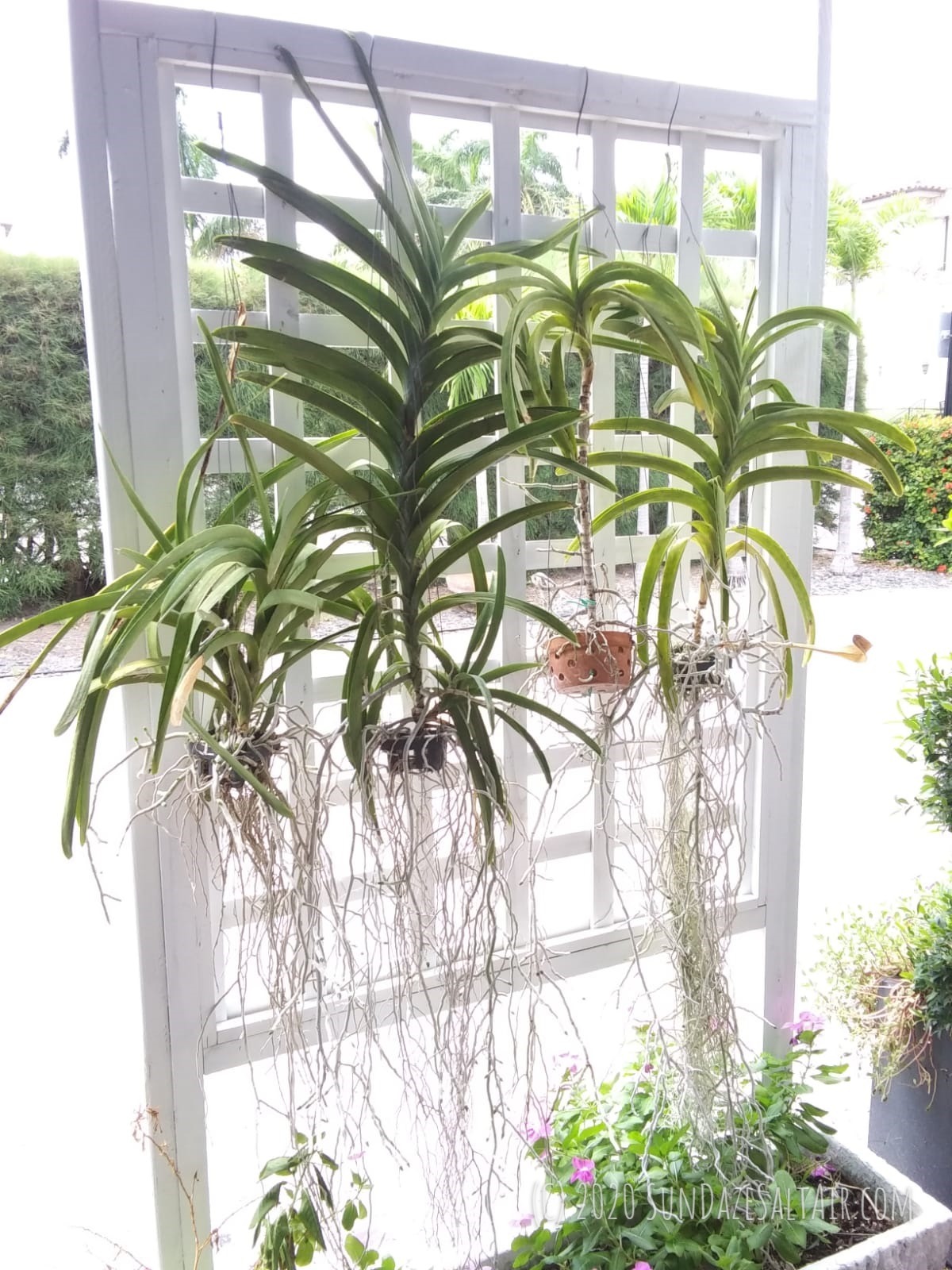
How Should I Grow My Vanda Orchids to Get Them to Bloom?
A defining characteristic of Vanda orchids is that they are epiphytic, meaning they grow in the open air, not soil, with numerous aerial roots sprouting from the main stem to absorb necessary nutrients and water from the environment. Therefore, not only is soil not needed, but you should ensure that your Vanda's air roots are uncovered by any medium to attain the maximum air circulation Vanda roots desire.
One excellent way to do this is to grow your Vandas hanging in slotted orchid baskets. These hanging baskets ensure your Vanda's aerial roots are exposed to allow it to obtain necessary moisture and nutrients from its surroundings, as well as vital ventilation. Such baskets also allow easy mobility to relocate your Vandas as needed.
How To Grow Vanda Orchids Indoors to Get Them to Bloom
Since Vandas are not dependent on soil for their growth, pots should not be a first choice for cultivating Vandas. Not only is it not practical as a result of their size and vertical growth pattern, but there are better options such as the aforementioned orchid baskets. Even if is tempting to pot Vandas that are grown in dry, indoor conditions so they hold more moisture, potting increases the chance of root rot if not well-ventilated.
Since the ideal household climate does not provide sufficient humidity for Vandas to grow well indoors, you will need to simulate humid conditions.
There are hybrid Vanda orchids sold at local garden centers that are advertised as being adapted to withstand the low humidity conditions common indoors, so you may want to inquire about those when shopping for a Vanda specifically for indoors.
The Preferred Method of Growing Vandas Indoors -- Hanging in Baskets
As stated above, the preferred method for growing Vandas, especially in dry indoor climates, enables Vanda roots enjoy their favorite thing -- constant air circulation. This means the aforementioned hanging orchid baskets where Vanda roots can grow through holes in the baskets and attach themselves. Growing Vandas in hanging baskets also makes watering your Vanda easier, since you can place your orchid in the shower or submerge the Vanda in the basket for quick hydration It also makes frequent misting easy, with less risk of root rot than potted specimens.
***TIP! Hang slotted orchid baskets near Eastern-facing windows for plenty of bright morning sunlight...
How To Grow Vanda Orchids Outdoors to Get Them to Bloom
If you are lucky enough to live in the subtropics or tropics where orchids can grow outdoors nearly wild, you have a few choices that make the most of Vanda's ability to grow bare root. When grown in high humidity areas such as the tropics, you can not only grow your orchid in orchid baskets, but you can also grow your Vanda gently tied to a tree. Both methods allow Vanda's air roots to take maximum advantage of any humidity and most closely mimic the conditions of Vanda's native habitat in the rainforests of Southeast Asia. Attached to trees or suspended from wooden, teak or plastic baskets also allows for easy daily watering of your Vanda during hot and dry periods.
***Find out, "How to Grow Orchids Bare Root Without a Medium or Pot Wherever You Live" here...
Did You Know?
In the wild, Vandas often cling to tree bark where they hang from trees in tropical rainforests, and they even grow from cracks in rocky surfaces or on cliffs. While these types of Vandas growing in rocks may be considered "terrestrial," they are still growing in virtually zero soil, only in what little organic matter happens to be collected in the rocks over time. By growing in "open air" conditions, Vanda's roots are able to effectively absorb everything they need from their environment for optimal health and blooming.
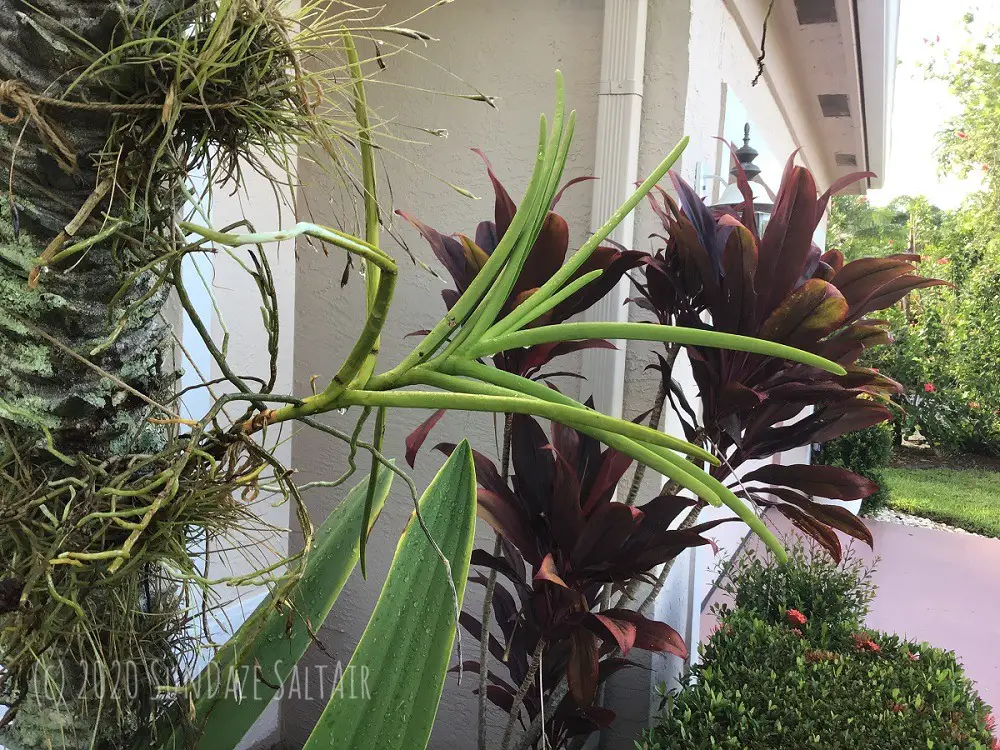
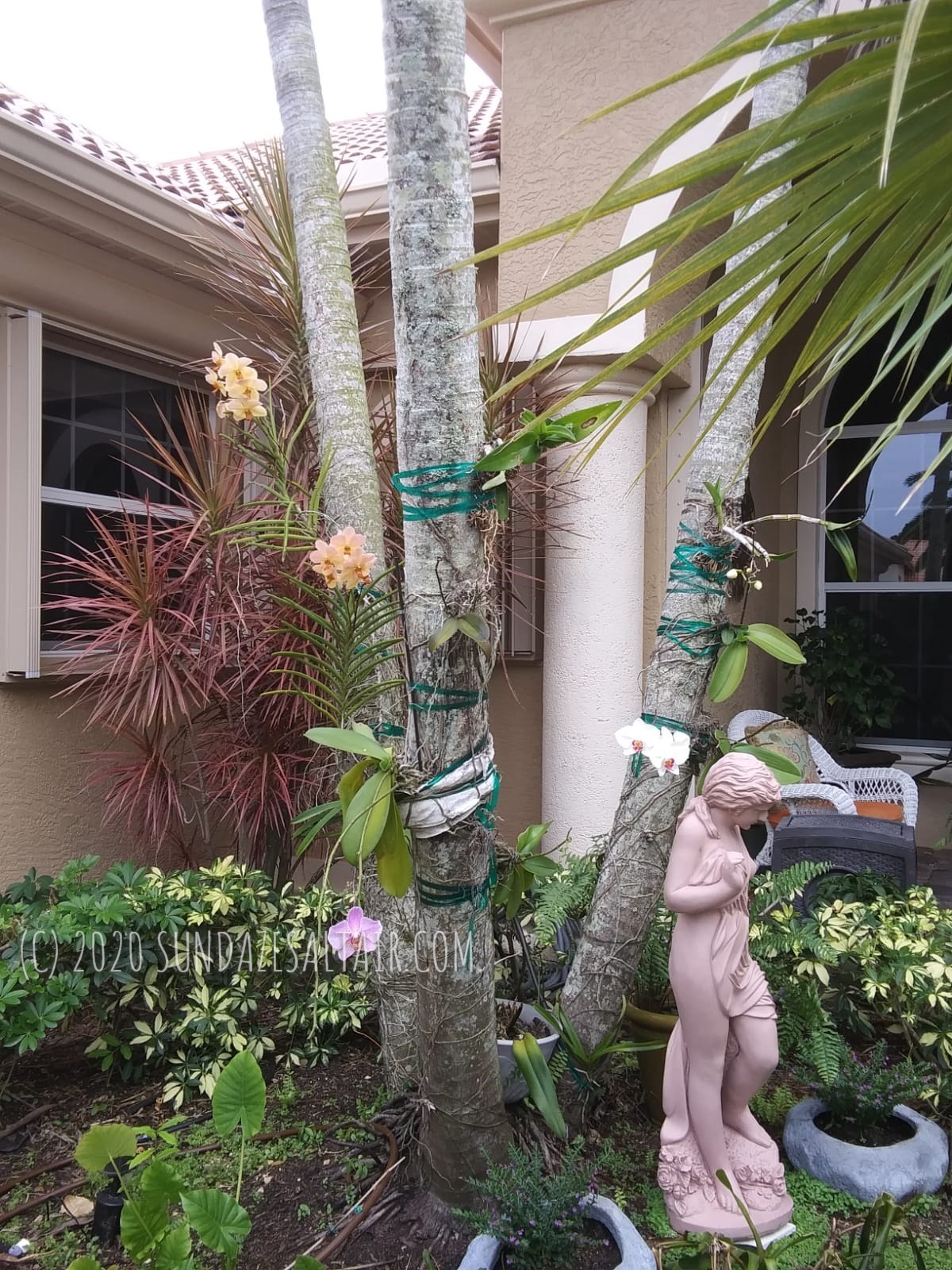
How Much Light Does a Vanda Orchid Need to Bloom? Consider The Three Types of Vandas
Light is a critical factor in blooming Vanda orchids. In general, as natives of tropical Southeast Asia, Vandas like heat and light and a lot of it, but prefer their sunlight indirect, like that which is received under trees in their native rainforest. Suspended from the tropical rainforest tree canopy, Vandas have access to greater sunlight than if they were on the forest floor while still being shielded by harsh direct sunlight from the tree canopy. There are, however, three different varieties of Vandas with slightly different preferences.
Terete Vandas
Terete Vandas are characterized by round yet pencil-shaped leaves and actually thrive in full sun, so are best grown in the sub-tropics or tropics where they get maximum light exposure, with no more than 25 to 35 percent shade. Leaves will be medium green, not dark green, if they get satisfactory sunlight.
Strap-Leaf Vandas
Strap-Leaf types of Vanda orchids, characterized by broad, flat and leathery leaves, actually prefer to be shielded from direct sunlight, so you will want to grow them in partial shade, especially mid-day in summer or in hot climates. In addition to protection from bright midday sun, Strap-Leaf Vandas may need more frequent waterings.
Semi-Terete Vanda
The third type of Vanda is the Semi-Terete Vanda which is actually a hybrid of the other two, but are similar to Strap-Leaf Vandas in that they lean toward preferring more partial shade especially at high noon and in hotter climates.
Adapt Your Vanda's Watering To The Amount Of Light They Receive
As always, the greater heat and sun the Vanda gets, the greater Vanda's need for water on account of the fact that Vandas lack pseudobulbs and the ability to really store water like sympodial orchids.
With Vandas growing outdoors, a stream of bright, yet filtered light like that which it receives attached to a tree is often ideal. If you are growing your Vanda indoors, place it near a window with Southern exposure for longer daylight exposure or near some grow lights, but monitor it's light needs according to the type of Vanda it is as described above. With greater light exposure, you may have to mist your Vanda's air roots regularly, up to twice a day, to prevent your Vanda from drying out.
How Do I Know If My Vanda Is Getting Enough Light to Bloom?
Your Vanda's foliage should be a nice medium shade of green, not dark green, if it is receiving sufficient light for blooming. If your Vanda hasn't bloomed in some time, you may want to consider that it is not receiving enough sunlight, and find a new, brighter location for your Vanda to call home, and see if that encourages blooming.
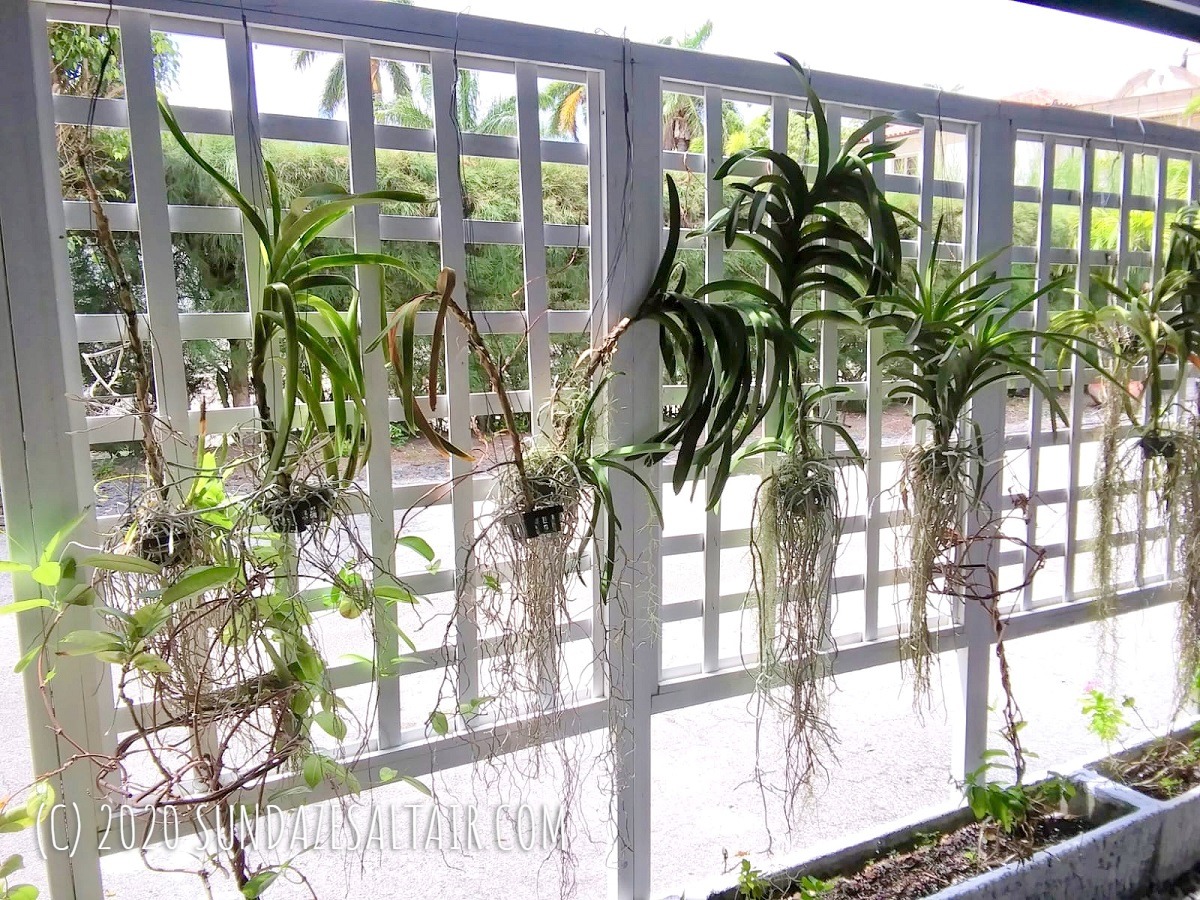
What Temperature Is Best For My Vanda To Bloom?
As expected of natives of the tropics, Vandas like warmth, so be sure to keep your Vanda in an environment where daytime temperatures hover between 80 and 90 degrees Fahrenheit (27 to 32 degrees Celsius) all day, and between 60 and 70 degrees Fahrenheit (16 to 21 degrees Celsius) at night. While they enjoy some chilly 50 degree range drops to promote flowering, Vanda orchids have little tolerance for very cold temps, save for rare exceptions like the Blue Coerulea Vanda which actually does quite well in colder temps. Anything below 40 degrees Fahrenheit (4 degrees Celsius) has the potential to permanently damage your plant and at the very least, prevent it from blooming.
The Vanda's Fussy Water & Humidity Requirements
Originating under canopies of trees in sultry, tropical Southeast Asia, Vandas may like to soak up filtered sun, but they also need to obtain regular hydration otherwise they will be at risk of drying out. Vandas are different from their orchid cousins such as Cattleyas and Oncidiums in that they don't have pseudobulbs that can absorb and store moisture and nutrients. Since Vandas absorb both water and food only through their air roots, storing both in their leaves, Vandas prefer frequent watering. Keep your Vandas roots moist and hydrated -- especially when it's hot out. In your efforts to do this, however, just be careful not to leave Vanda in soggy conditions -- which is the opposite of the airy, well-ventilated conditions Vandas crave.
How To Provide Humidity for an Indoor Vanda - Simulating Humid Rainforest-Like Conditions in Dry Homes
Since Vanda orchids love a lot of humidity, if you happen to be in possession of an indoor Vanda, you may want to try a humidifier and frequent misting of the surrounding air. Although some garden centers do now advertise and sell hybrid Vandas that are supposed to be adapted to survive in low humidity indoor settings.
One way to do this is by keep a "humidity tray" of water and pebbles near, but not touching, your Vanda. If done properly, your Vanda will appreciate the increased humidity from the evaporating water without experiencing any harm to its roots. Another option is to loosely surround or pack damp sphagnum moss near the bare roots to provide much-needed moisture. This is not a first choice but it is an option -- just be sure to monitor it as it can dry out quickly indoors while offering too much dampness in humid conditions.
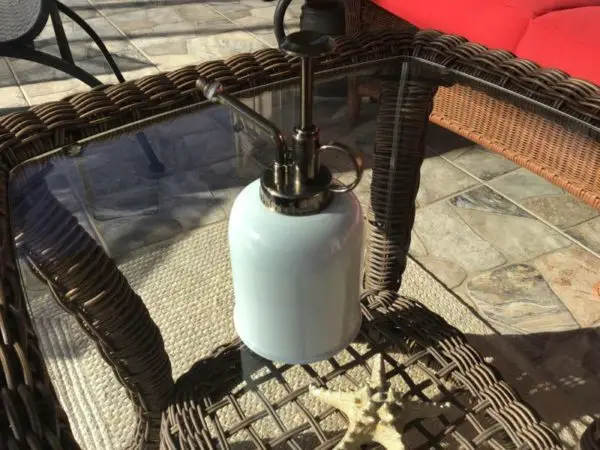
How Much Water Does My Vanda Need? Water Your Vanda More Frequently The Hotter It Gets & The Closer to the Equator You Live
Owing to their inability to store water, during periods of high temperatures and intense sun, you may even want to water your Vanda twice a day. This means that during the hottest time of the year, generally during the dog days of summer, water early in the day for up to fifteen minutes, and if the roots look dry later on, you can provide them another short drink. If you do water your Vanda initially for a bit longer, say fifteen minutes, you may notice your Vanda's roots are still greenish even later in the day, indicating they do not need any additional water as they are still sufficiently hydrated.
Of course, if you live somewhere with a wet rainy season, you will want to modify and cut back on watering your Vanda.
How Often Should You Water Vanda Orchids During the Winter?
When your Vanda is exposed to more mild temperatures and less light during the winter, you should cut back on watering to every two to three days but keep a close eye for signs of dryness. If you live in a hotter climate with a mild winter, you may still want to water daily if your Vanda receives a lot of sun.
How Do You Know If Your Vanda Orchid Needs Water or Is Satisfied?
To know if your Vanda orchids are in need of water, always takes a look at the roots. If the roots are silvery or whitish grey, then your Vanda orchid is dry and could use some water. The white air roots of your Vanda will turn green following a good soaking. Once you notice this change, you can be sure your Vanda has had enough to drink. Hydration is critical is ensuring a healthy plant and is a vital part in helping encourage your Vanda to bloom.
If you have a terrestrial Vanda that is in some sort of potting medium, first make sure that the potting medium is something like a chunky bark or coconut husk, basically a gritty medium that facilitates drainage and prevents root rot. Check the potting medium daily for dryness before you water.

Continuous Air Circulation Is Important for Vandas
Once you have soaked your Vanda in water, always be sure to completely remove it from the water and return it to hang in a warm, sunny spot with good and open-air circulation. This will allow the plant and its roots to completely dry before nightfall, and avoid fungus and disease as a result of dampness and exposure to cooler nighttime temperatures. If you have indoor Vandas, you may want to place them near, but not directly in front of, a portable fan so they get air circulation to help them dry without subjecting them to any drafts.
Should I Fertilize Or Feed My Vanda Orchid? Feeding Requirements For Vandas
As discussed earlier, Vandas are different from other types of orchids in that they lack a pseudobulb that would otherwise store food and water for the orchid's survival. Instead, they rely on their air roots and what can be absorbed through them. As a result, Vandas benefit greatly from a feeding of orchid fertilizer every few waterings throughout the growing season. Find out how to fertilize your Vanda for maximum blooming here. In addition to their inability to store nutrients, Vandas also tend to bloom more frequently than other orchids causing them to have heavier feeding requirements than other plants,
Propagation Or How to Get New Vanda Orchids from Cuttings
Most monopodial orchids such as Vanda and Arachnis can be propagated by tip cuttings to create a whole new plant.
Conclusion: Bookmark & Share these Vanda Blooming Guidelines
While it is possible for these breath-taking beauties to bloom up to several times throughout the year, Vandas are notoriously particular about their growing and blooming conditions. Bookmark and share these Vanda blooming guidelines so you can recreate the ideal environment for a healthy and prodigiously blooming Vanda where you live.
Once you do, your Vandas will reward you with large, ethereally colorful blooms every few months.
**********
Have you tried growing Vanda orchids? Tell us down below about your experience growing and blooming the beautiful, enchanting Vandas...


You May Also Like
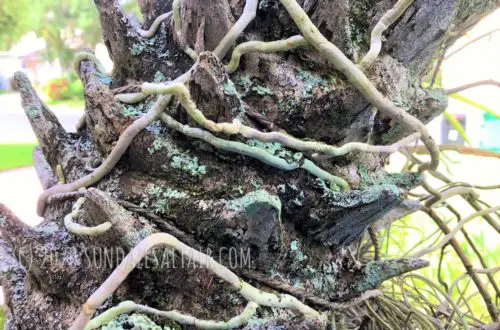
How To Easily Remove An Orchid From A Tree Even If Its Roots Are Well-Attached
August 4, 2021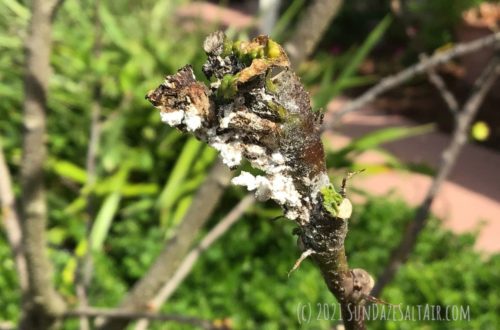
What Is This White Fuzz On My Hibiscus? How To Rid A Hibiscus Of Mealybugs
October 20, 2021